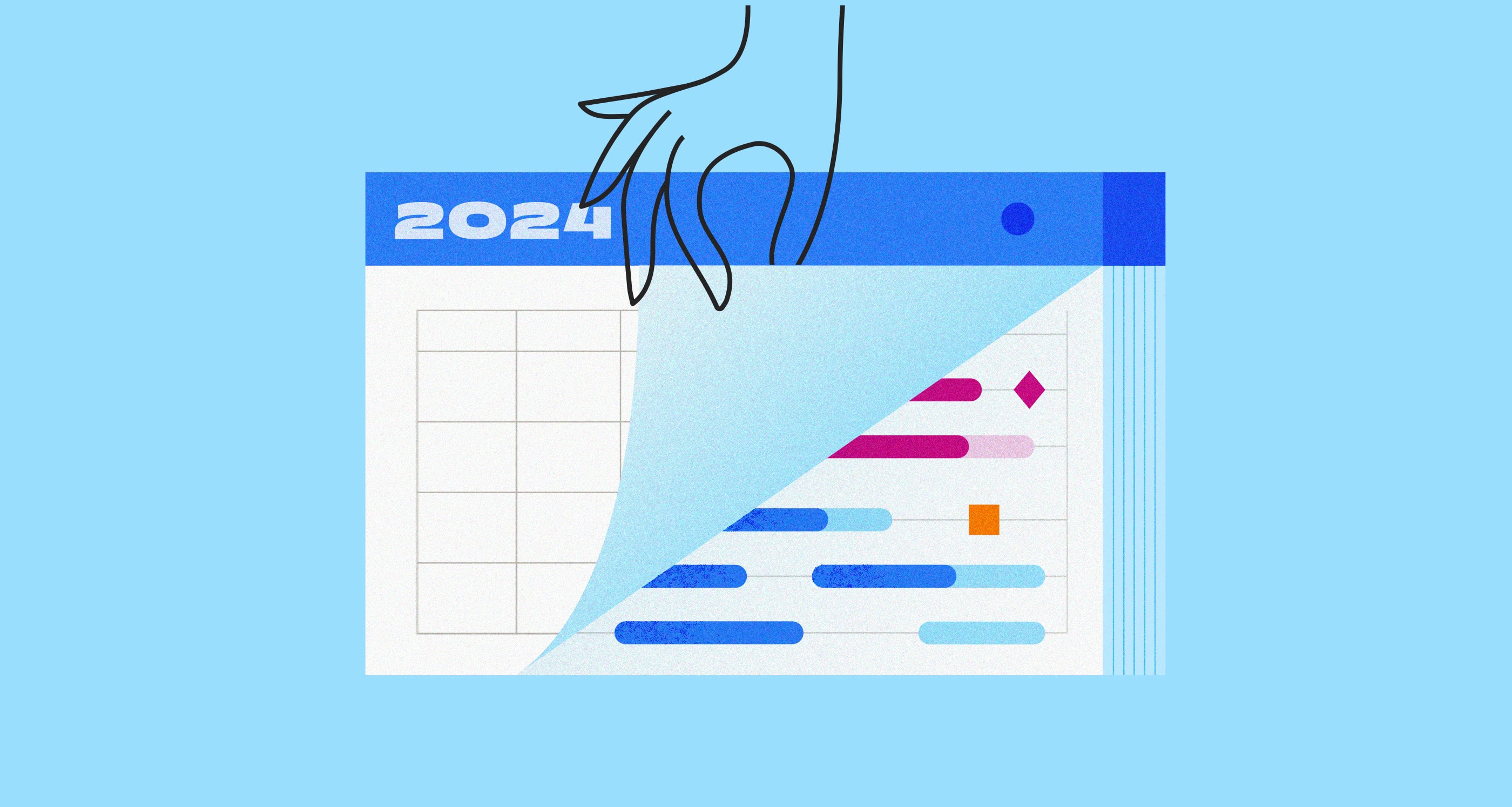Before setting a project in motion, you must lay the foundation for success: assembling the necessary resources. These resources encompass various project components, from essential equipment and tools to the most valuable asset of all — people.
Resource management, a fundamental aspect of project planning and execution, revolves around the strategic allocation and use of these assets. It's the process that ensures you have the appropriate equipment and team members to deliver a project on time and on budget.
Let’s explore the intricacies of resource management, its significance, and best practices that empower project leaders to achieve optimal results.
What’s resource management?
Resource management in project management involves planning, sourcing, and allocating the technology, personnel, and money your team requires to tackle an initiative. It's about ensuring the right tools are available at the right times to complete work. In larger organizations, this work is often carried out by a resource manager, though some project managers take on the responsibility themselves.
In order to manage a company’s resources, the person responsible must be able to see and track all the assets each department requires. In many cases, it's not just your team that needs these resources — you share them with other departments. This is especially true for people who may be working on multiple projects at the same time, like a graphic designer or IT staff member.
The key to managing shared resources — including employees, money, office space, and technology — is to have a clear and organized method to keep track of them. This way, your organization can balance, prioritize, and delegate resources efficiently and effectively.
Resource management techniques
A resource management system is more than a diagram scribbled on a whiteboard. Here are three advanced techniques for managing time, skills, and finances:
- Resource allocation is taking advantage of your current resources as efficiently as possible. Focusing on the core skills and workload availability of your existing team members, this technique relies on transparency and precise scheduling to shuffle resources between projects and maximize productivity.
- Resource leveling comes into play when there are team members with multiple skill sets. Imagine you have a developer who also knows how to do some graphic design. Depending on their workload, they might be able to assist with the design part of their project, meaning the work no longer requires the allocation of a full-time design resource. Leveling ensures the full use of any underused employee skills that are relevant to the project and frees up assets for use elsewhere.
- Resource forecasting helps predict available resources before a project moves from planning to implementation. This is where the project management software chart comes in handy, as it allows the resource manager to see an up-to-date schedule of projects and assets. Equipped with this data, they can assume future needs and allot resources accordingly.
Why is resource management important?
If you were selling resource management as a product, you'd tell customers that it flat-out saves time and money. When done correctly, the process can improve a project’s profitability and sustainability by distributing your most important resources effectively and cutting down on stalls and roadblocks.
Let’s explore five benefits of resource management in greater depth:
1. Lower costs
When the important resources are visible to the entire organization, it helps control spending and reduce expenses. Leaders and project managers can schedule tasks to avoid delays and unnecessary costs if they know which tools and people are available and when.
For instance, if a resource manager is aware the company’s in-house UX designer is free for three days next week, they can swap UX-related work for other tasks this week to avoid expensing a third-party designer to work on the project. Ultimately, this leads to savings, making both project managers and leadership happy.
2. Effective allocation
Resource management ensures employees stay productive and engaged, eliminating idle time between projects. With clear visibility into available personnel, managers can assign staff to non-billable work as needed, preventing their skills from going to waste and maximizing their contributions to the organization.
3. Closed skill gaps
Proper resource management allows leaders to manage the organization's current capacity and balance it with project requirements. By reallocating personnel across departments or projects, hiring new employees, or investing in technology, your business can proactively address skill gaps and ensure resources are always readily available.
4. Strong collaboration
In large organizations, resources can become lost in the shuffle. Perhaps the resource manager accidentally overlooked a person’s peripheral skills or assigned one department the majority of valuable resources.
Implementing a shared project management tool reduces the risk of this kind of slip-up because everyone in your organization can track its assets and flag potential problems before they create serious roadblocks. As a result, resource transparency fosters a more collaborative and productive work environment.
5. Enhanced value
A formal strategy for managing resources highlights specific skill sets that shine within the organization and showcase employees' contributions beyond their current roles. This added value becomes evident when it's time for promotions or nurturing emerging skill sets. Recognizing and investing in employee development boosts morale and demonstrates that hard work is appreciated and rewarded.
Consequences of poor resource management
On the flip side, overlooking proper resource management can have serious consequences. By giving careful attention to asset planning and allocation, your company can avoid these common pitfalls:
- Increased costs: Inadequate knowledge of available resources results in wasted time and money. This could involve the unnecessary procurement or allocation of high-cost resources when less expensive solutions were available.
- Poor performance: Failing to manage resources effectively can lead to unrealistic workloads. Perhaps a person was given too much to do, or assigned tasks that don’t fall within their skill set. Whatever the case may be, mistakes like these not only result in dissatisfied staff but also contribute to employee burnout.
- Significant delays: Without proper resource allocation and scheduling, you wind up with stalled projects. And the more time a project takes to complete, the more expensive it becomes.
- High turnover: Misusing employees and their skills may cause them to leave. You could wind up losing an incredible asset because they felt overlooked, neglected, or disrespected.
- Unhappy clients: When projects are late because of resource mismanagement, clients aren't going to stick around to watch you refine your processes. Instead, they’ll find an organization that’s equipped to handle their needs and deliver high-quality results.
What’s a resource plan?
The resource management plan is a crucial component of your project plan that carefully outlines all the assets you require for each phase. The comprehensive list should cover these five key components, necessitating some forecasting:
- Resource overview: List all the necessary resources, from people and technology to office space, ensuring nothing is overlooked. Remember to factor in associated costs and be realistic in your projections. The focus should be on identifying the overall skills and technological needs required for the project.
- Human resources: Break down the number of people you need for each step of the project and define their roles within each phase. This tells the resource manager who you require and when so they can plan accordingly.
- Quantities and costs: Quantify your needs and conduct a cost analysis. How much does it cost to access a UI engineer, and how many will you require? The goal is to provide a clear picture of the financial implications of each step in the project’s implementation.
- Timeframes: In addition to financial analysis, establish timeframes for each resource's use. How many hours will the three UI engineers work for? This information helps the resource manager match resource availability with project timelines.
- Risks: Anticipate and document any challenges or potential risks associated with specific resources throughout the project's lifecycle. Being proactive in identifying problems allows for timely mitigation and resource optimization.
How to implement an effective resource management plan
Whether you're a resource manager, project manager, or simply excel at creating stunning spreadsheets, these 6 steps will guide you through executing your plan:
1. List everything
Start by creating a detailed list of all project tasks, their due dates, and start dates. Before moving on to the next step, double-check that you haven’t missed anything.
2. Assign resources
Once you have your task list, it's time to allocate resources accordingly. Whether it's people, servers, or other assets, make sure to communicate these assignments with your team and stakeholders for clarity.
3. Manage scheduling
Keep a close eye on scheduling as you align resources with tasks. Consider employee vacations, PTO, and other departmental resource needs.
4. Track time
Monitor the usage of every resource hour to stay on track with the project timeline and budget. Use timesheets or Gantt charts to manage schedules and timelines and make them accessible to everyone on the team.
5. Review allocations
Regularly assess how resources are balanced and distributed across the project. This helps maintain workload equilibrium and enables swift resource reallocation if any task falls behind.
6. Monitor progress
Optimize productivity by reviewing progress through reports (a function available in most resource management software products). Ensure the right resources are assigned to every task as you move through each phase and make resource allocation decisions as efficiently as possible.
Manage your resources with Roadmunk by Tempo
Managing your resources and projects is much easier when you have the tools to streamline projects and data collection. Enter Roadmunk by Tempo, your go-to solution for creating audience-friendly roadmaps that facilitate resource allocation. Combine this tool with Tempo Planner, a JIRA-enabled time-tracking software that allows project managers to effortlessly view resource availability in one centralized platform — even if your teams are dispersed across different office locations or working remotely.









